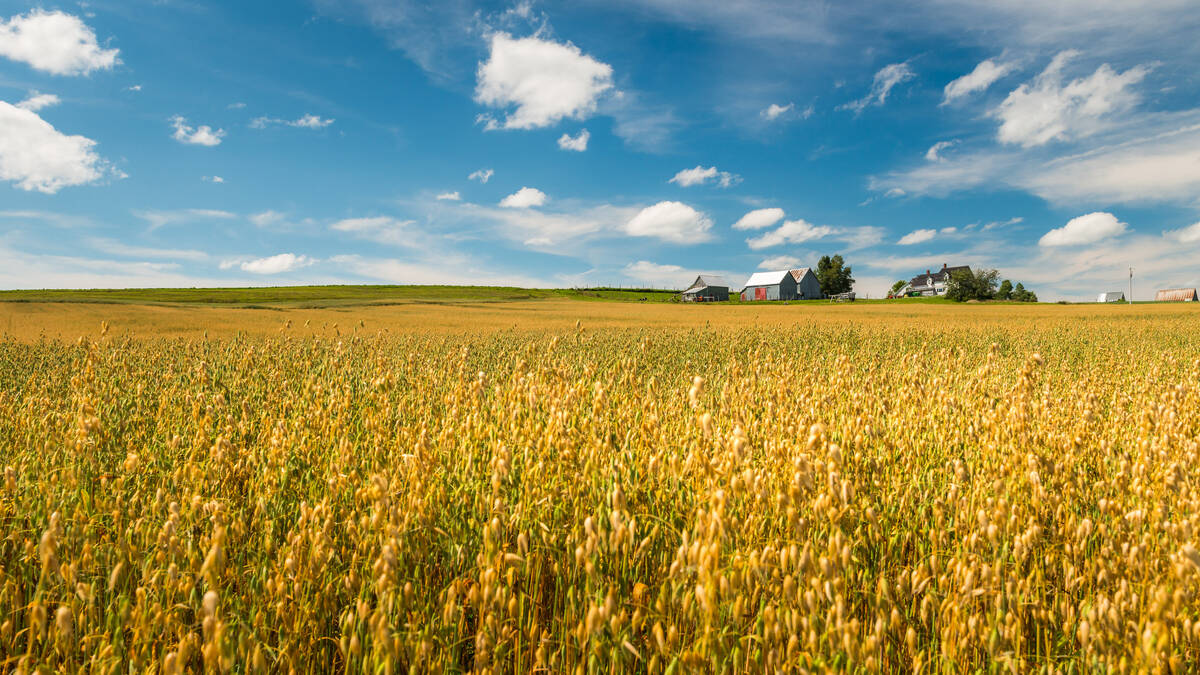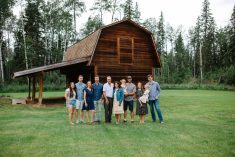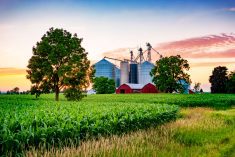The primary reason for the success and growth of North American agriculture has been the ability of Canadian and U.S. farmers to do two seemingly contradictory things simultaneously: increase productivity and at the same time, reduce production costs.
By doing both, farmers remained competitive in the global marketplace despite decades of declining commodity prices.
Unfortunately, too many of us today may be focused entirely on maximizing production. At the very least, some of us have de-emphasized the role of cost management in profitability.
Read Also

Risk management for the farm means considering people, too
Wheat fields in New Brunswick, Canada.
The most visible result is that input costs are skyrocketing. At the same time, however, farmers break-even costs are rising. That means the risk that farmers bear is going up exponentially, and most importantly, our production is becoming less competitive in the global marketplace.
Agricultural experts Brian and Darren Hefty pointed out some of the risks of not controlling costs last December when they provided a breakdown of the 2010 average cost per acre for growing corn on a 2,000-acre Northern Plains farm and compared it to their costs six years earlier on the same farm.
The shocking result is that costs nearly doubled in those six years, climbing from $280 per acre in 2004 to $545 per acre in 2010.
Many farmers will respond that yield increases more than compensate for the cost. And that is true. Farmers are getting a lot more production. According to the Hefty brothers, the area s average corn yields have jumped from 125 bushels per acre to 175 bushels over the same time of six years.
So bins are bursting and farmers are smiling. Or are they? Farmers who take the time to calculate
their production costs on a cost-per-bushel basis aren t so happy. Based on the Heftys average figures, the cost of producing a bushel of corn in 2004 was $2.24. Yet even though farmers increased their yields by a third, the increase in costs drove the 2010 cost of production of corn up to $3.11 per bushel.
Also look where the costs are rising. Over 80 per cent of the increase is due to higher costs for land, fertilizer and seed. Each of these costs has been driven up by the quest for higher yields, and all three are rising as a result of farm management decisions. Farmers willingly pay more for seed which promises higher yield. But to obtain those higher yields farmers must increase their fertilizer rates, driving up fertilizer prices. And the higher yields that are being harvested encourage not only landlords to seek higher rents but push farmers to agree to higher rents.
In effect, farmers quest for higher yields is the main driver of higher production costs.
You increase profit by increasing yields and by controlling costs, Brian points out. You should not be spending money needlessly. One of farmers biggest costs today is fertilizer and fertilizer is probably the input farmers know the least about.
Can your soil even hold all the nitrogen needed for the yields you want? Hefty asks. He points out soil ions can only hold so much nitrogen, and applying more fertilizer than the soil can hold not only wastes money but is inviting more regulation of the farm industry.
Proper fertilizer application can also reduce costs. Hefty says he has helped farmers reduce their fertilizer requirements by 50 per cent without any yield loss simply through adopting better fertilizer placement practices.
Of course, corn prices have also risen, which is another reason for the increased rents and land costs. But have corn prices risen enough to compensate for the higher costs? Interestingly, if corn is $5 a bushel (roughly double the average U.S. corn price from 1973-2006) the 2010 average yield of 175 bushels would net a farmer $330 per acre before labour, management and taxes. However, had land, seed, and fertilizer prices not increased, and the farmer had fertilized for the same 125-bushel yields he got six years earlier his net profit would have been $345 per acre!
At $5 a bushel, if farmers could have kept costs down to 2004 levels, they would have made more money growing the 2004 average 125 bushels than farmers today who maximize inputs and get the average yield of 175 bushels.
Worse yet, the added risks are bigger than we might first think. Hefty calculates that to put in 2,000 acres of corn, a farmer has to spend over $1 million before a single kernel is harvested.
Losses due to weather also increase as farmers strive for higher yields. Dryland farmers generally have a much better chance of getting sufficient rainfall to make a 125-bushel crop than to get a 175-bushel crop.
Price risks make production risks look minimal. Most agricultural economists have been predicting corn prices to average over $4 per bushel for the foreseeable future, which would be a profitable level with input costs of $3.11. This 75 per cent price jump over the previous long-term average is largely due to biofuel demand. But is that demand real or the result of public policy? After all, if oil drops to $50 per barrel, the break-even price of corn which ethanol producers could pay would be $2.18 per bushel, well below farmers current cost of production.
As prices increase, we also tend to see increased volatility. In June 2011 the futures price of corn ranged from $5.75 to $7.22. That $2.50 movement in price is greater than the average price of corn over the last 40 years.
Yet the biggest risk farmers face is the current high prices resulting in a glut of corn being produced and prices falling as a result of oversupply, especially if that corn isn t produced with a closer eye on its cost.CG
———
THE END OF FOOD
Corn isn t the only crop that is costing farmers more to produce. The same trend is hitting most crops and possibly the entire food production system. Paul Roberts is a journalist and author of the book THE END OF FOOD and he too warns the U.S. cost of production is going up.
This increase in the cost of production is in direct contrast to the basic conclusion that Roberts reaches in his book: to be competitive in the global market, farmers must continue to lower their costs of production.
Roberts says that to drive down per-bushel production costs, farmers employ new technology, equipment and management trying to produce higher yields and spread the cost of production over more production units. As a result, however, supply tends to go up faster than demand, so prices begin to fall.
In response, farmers are forced to invest in more technology to again increase yields to compensate for falling prices.
According to Roberts, farmers have managed to keep up on this technology treadmill for over a half-century. But Roberts wonders if the cost of new technology now supersedes its rewards. Roberts quotes Chad Hart of Iowa State University who says: In the United States we have the infrastructure in place so there is not a lot of cost to squeeze out. But in Brazil and in Argentina, they have lots of costs left to squeeze.
According to Roberts, the failure to control production costs may result in the loss of markets as the U.S. loses its competitive edge.
While Roberts does a great job describing the current food system, his book doesn t provide an alternative path. However in speaking with him, Roberts suggests farmers be very cautious and fully utilize risk management strategies.
Keep an eye on the short term, Roberts says. Don t get locked into needing the current high prices to be profitable and trusting that land prices are going to keep going up. Be prepared for uncertainty.
———
ABOUT HEFTY SEED COMPANY
They don t deliver. They don t offer credit. They don t scout your fields. But everybody who buys at Heftys gets the same price, guaranteed
Even as the consolidation of local farm supply outlets continues across Canada, Brian and Darren Hefty are opening new Hefty Seed Company stores across the U.S. Midwest. From a single farmyard sales site started by their father Ron in the late 1960s, the family has expanded their ag business to 29 stores across seven states, retailing fertilizer, ag chemicals, seed, and speciality equipment to farmers.
This is on top of farming 2,500 acres, operating a seed-cleaning facility, and creating and producing a weekly ag television show, hosting regular radio spots, publishing a newsletter and maintaining a website.
In 1969 my dad sold his small north-central Iowa farm and purchased my mother s parents farm in South Dakota, says Brian. He moved from a very progressive farming area with some of the best farmland in the world to a place where no one was using herbicides!
The few herbicides that the local elevator carried were too high priced so Hefty s father drove the 200 miles back to Iowa to buy the herbicides he and a few neighbours needed for their farms. That year, other farmers were so impressed with Dad s weed control that Hefty Farm Supply was created to supply herbicides to the growing number of farmers who wanted to use herbicides, Hefty recalls.
The name of the company was changed in 1984 to Hefty Seed Company to coincide with the opening of a seed-cleaning plant on the farm and their increased sales of seed. Over time they also expanded into fertilizer sales, farm equipment and storage bins.
Like most farmers, the Heftys regularly attended winter workshops and summer field days to learn about new products and technology. However, they felt many of the talks were simply glorified sales pitches, with company reps only telling the gathered farmers how great their product was.
In 1996, after sitting through a three-hour evening meeting where they felt they didn t hear anything they could use back home, the Heftys said to each other that there had to be a way to get better, unbiased information.
It was a conversation that led to major changes in the way Hefty Seed Company does business.
The brothers began to host crop production workshops where they and other farmers would meet to share production information and tell each other what worked well on their farms. There were no reps, no drinks, and no sales pitches for any products or even for Hefty Seeds.
When a local television station asked if the Heftys would advertise their workshops on the region s existing ag television show, the brothers turned the station down.
Then father Ron suggested they could do a program of their own. In 1998 Darren and Brian wrote and hosted the first of what was to become a weekly television appearance by the brothers. Unlike most ag shows that focus on markets and weather, the show called AgPhD is all about production. Rather than talking about things farmers have no control over, Brian says, we focus on things they can control, like weeds.
Today, AgPhD has aired nearly 700 episodes and is viewed across the U.S. on satellite television.
Keeping costs low is the second priority of Hefty Seeds. They do not offer custom application services. Nor do they deliver products to the farm or offer credit on sales. Instead of scouting fields, they teach farmers how to scout their own.
Perhaps most importantly, they have one price for all customers, big and small.
The Hefty family has also turned their 2,500-acre farm into a large test facility. They test hundreds of ag products on their own farm operation each year so they can give their customers real, unbiased data of the performance of the products they sell.
Given the fact Brian not only farms but also manages a chain of farm supply outlets, conducts seminars, and is a television personality I wondered what title he wanted used to describe him in this article. Manager, businessman, or even entrepreneur all seemed lacking. His answer was simple. No. 1 he is an agronomist.
Hefty s focus on his farm, in his farm supply stores, and in his workshops and on AgPhD is making things grow. Our goal is to help farmers raise better crops, thereby providing safest and most abundant food for the world and helping you make more money, Hefty says. We try to help someone every day.















